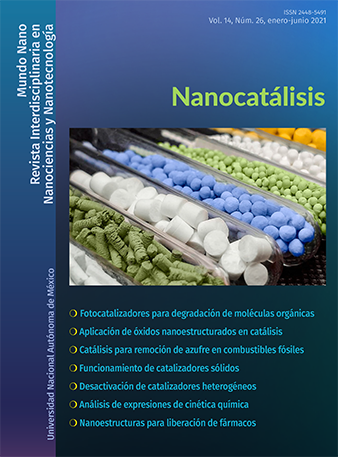Entre la comprensión y la predicción del funcionamiento de catalizadores sólidos
Resumen
El descubrimiento de catalizadores sólidos generalmente se realiza a través de una metodología que incorpora elementos de prueba y error. En el mejor de los casos, esta estrategia se apoya en información obtenida de técnicas de caracterización. Sin embargo, como la estructura de los catalizadores sólidos es generalmente complicada, dicha información es insuficiente para tener una descripción precisa y rigurosa del modo en que funcionan los catalizadores. Además, la estrategia tampoco permite establecer si los catalizadores encontrados serán los mejores posibles. Como contraparte de la prueba y error está el diseño de catalizadores, con el cual se pretende desarrollar materiales a partir de su comprensión a nivel fundamental (i.e., detalles específicos y rigurosos de la naturaleza del sitio activo). En principio, el diseño permitiría predecir la estructura necesaria en un material para que este sea catalíticamente activo. En este trabajo se contrastan las estrategias que típicamente se emplean para estudiar catalizadores sólidos, poniendo énfasis especial en la posibilidad de diseñar materiales. Se discute qué significa comprender el funcionamiento de los catalizadores a nivel fundamental y se hace un análisis crítico de posibles oportunidades que ofrece el diseño para abordar algunos problemas relevantes en el estudio de catalizadores en la actualidad.
Citas
Argo, A. M.; Odzak, J. F.; Lai, F. S.; Gates, B. C. (2002). Observation of ligand effects during alkene hydrogenation catalysed by supported metal clusters. Nature, 415: 623. https://doi.org/10.1038/415623a
Bond, G. C. (1991). Supported metal catalysts: some unsolved problems. Chemical Society Reviews, 20:441. https://doi.org/10.1039/CS9912000441
Breslow, R. (1995). Biomimetic chemistry and artificial enzymes: catalysis by design. Accounts of Chemical Research, 28:146. https://doi.org/10.1021/ar00051a008
Brown, J. M; Evans, P. L.; Lucy, A. R. (1987). Stereochemistry of intermediates in homogeneous hydrogenation catalysed by tristriphenylphosphinerhodium chloride, employing nuclear magnetic resonance magnetisation transfer. Journal of the Chemical Society, Perkin Transactions, 2(1): 1589. https://doi.org/10.1039/P29870001589
Burch, R.; Breen. J. P.; Meunier, F. C. (2002). A review of the selective reduction of NOx with hydrocarbons under lean-burn conditions with non-zeolitic oxide and platinum group metal catalysts. Applied Catalysis B: Environmental, 39(4): 283. https://doi.org/10.1016/S0926-3373(02)00118-2
Corma, A. (2016). Heterogeneous catalysis: understanding for designing, and designing for applications. Angewandte Chemie. International Edition, 55(21): 6112. https://doi.org/10.1002/anie.201601231
Corma, A.; Corresa, E.; Mathieu, Y.; Sauvanaud, L.; Al-Bogami, S.; Al-Ghrami, M. S.; Bourane, A. (2017). Crude oil to chemicals: light olefins from crude oil. Catalysis Science & Technology, 7: 12. https://doi.org/10.1039/C6CY01886F
Corma, A.; García, H.; Llabrés i Xamena, F. X. (2010). Engineering metal organic frameworks for heterogeneous catalysis. Chemical Reviews, 110(8):4606. https://doi.org/10.1021/cr9003924
Daniel, C.; Koga, N.; Han, J.; Fu, X. Y.; Morokuma, K. (1988). Ab initio MO study of the full catalytic cycle of olefin hydrogenation by the Wilkinson catalyst RhCl(PR3)3. Journal of the American Chemical Society, 110(12): 3773. https://doi.org/10.1021/ja00220a010
Darbre, T.; Reymond, J.-L. (2006). Peptide dendrimers as artificial enzymes, receptors, and drug-delivery agents. Accounts of Chemical Research, 39(12): 925. https://doi.org/10.1021/ar050203y
De Blasio, N.; Wright, M. R.; Tempesti, E.; Mazzocchia, C.; Cole-Hamilton, D. J. (1998). The relative importance of heterogeneous and homogeneous methanol carbonylation using supported rhodium catalysts in the liquid phase. Journal of Organometallic Chemistry, 551(1-2): 229. https://doi.org/10.1016/S0022-328X(97)00438-5
De María, R.; Díaz, I.; Rodríguez, M.; Sáiz, A. (2013). Industrial methanol from syngas: kinetic study and process simulation. International Journal of Chemical Reactor Engineering, 11(1): 469. https://doi.org/10.1515/ijcre-2013-0061
Dessau, R. M. (1986). Catalysis of Diels–Alder reactions by zeolites. Journal of the Chemical Society, Chemical Communications, 1: 1167. https://doi.org/10.1039/C39860001167
Ertl, G. (2018). Heterogeneous catalysis: where are we? Catalysis in Chemistry and Biology, 1: 61. https://doi.org/10.1142/9789813237179_0012
Fierro-González, J. C.; Bhirud, V. A.; Gates, B. C. (2005). A highly active catalyst for CO oxidation at 298 K: mononuclear AuIII complexes anchored to La2O3 nanoparticles. Chemical Communications, 1(42): 5275. https://doi.org/10.1039/B509629D
Fierro-González, J. C.; Gates, B. C. (2004). Mononuclear AuIII and AuI complexes bonded to zeolite NaY: catalysts for CO oxidation at 298 K. Journal of Physical Chemistry B, 108(44): 16999. https://doi.org/10.1021/jp046171y
Fihri, A.; Bouhrara, M.; Nekoueishahraki, B.; Basset, J.-M.; Polshettiwar, V. (2011). Nanocatalysts for Suzuki cross-coupling reactions. Chemical Society Reviews, 40(10): 5181. https://doi.org/10.1039/C1CS15079K
Foster, D. (1979). Mechanistic pathways in the catalytic carbonylation of methanol by rhodium and iridium complexes. Advances in Organometallic Chemistry, 17:c255. https://doi.org/10.1016/S0065-3055(08)60325-1
Gallego, E. M.; Paris, C.; Cantín, A.; Moliner, M.; Corma, A. (2019). Conceptual similarities between zeolites and artificial enzymes. Chemical Science, 10: 8009. https://doi.org/10.1039/C9SC02477H
Gates, B. C. (1995). Supported metal clusters: synthesis, structure, and catalysis. 95(3): 511. https://doi.org/10.1021/cr00035a003
Goodman, D. W. (2008). Precious little catalyst. Nature, 454: 948. https://doi.org/10.1038/454948a
Hamada, H. (1994). Selective reduction of NO by hydrocarbons and oxygenated hydrocarbons over metal oxide catalysts. Catalysis Today, 22(1): 21. https://doi.org/10.1016/0920-5861(94)80090-1
Haynes A. (2010). Catalytic methanol carbonylation. Advances in Catalysis, 53: 1. https://doi.org/10.1016/S0360-0564(10)53001-3
Haynes, A.; Maitlis, P. M.; Morris, G. E.; Sunley, G. J,; Adams, H.; Badger, P. W.; Bowers, C. M.; Cook, D. B.; Elliott, P. I. P.; Ghaffar, T.; Green, H.; Griffin, T. R.; Payne, M.; Pearson, J. M.; Taylor, M. J.; Vickers, P. W.; Watt, R. J. (2004). Promotion of iridium-catalyzed methanol carbonylation: mechanistic studies of the Cativa process. Journal of the American Chemical Society, 126(9): 2847. https://doi.org/10.1021/ja039464y
He, H.; Yu, Y. (2005). Selective catalytic reduction of NOx over Ag/Al2O3 catalyst: from reaction mechanism to diesel engine test. Catalysis Today, 100(1-2): 37. https://doi.org/10.1016/j.cattod.2004.11.006
Jentoft, R. E.; Tsapatsis, M.; Davis, M. E.; Gates, B. C. (1998). Platinum clusters supported in zeolite LTL: influence of catalyst morphology on performance in n-Hexane eforming. Journal of Catalysis, 179: 565. https://doi.org/10.1006/jcat.1998.2229
Jira, R. (2009). Acetaldehyde from ethylene—a retrospective on the discovery of the Wacker process. Angewandte Chemie, International Edition, 48(48): 9034. https://doi.org/10.1002/anie.200903992
Liu, W., Rodriguez, P., Borchardt, L.; Foelske, A.; Yuan, J.; Herrmann, A. K.; Geiger, D.; Zheng, Z.; Kaskel, S.; Gaponik, N.; Kotz, R.; Schmidt, T. J.; Eychmuller, A. (2013). Bimetallic aerogels: high-performance electrocatalysts for the oxygen reduction reaction. Angewandte Chemie International Edition, 52: 9849. https://doi.org/10.1002/anie.201303109
McNaught, A. D. y Wilkinson, A. (1997) Compendium of Chemical Terminology, 2a ed. (the “Gold Book”). Oxford: Blackwell Scientific Publications. IUPAC. [ISBN 84-7738-955-1].
Minami, T.; Shimokawa, K.; Hamato, K.; Shiroto, Y.; Yoneda, N. (1994). Supported rhodium catalyst, method of preparing same and process of producing acetic acid by methanol carbonylation using same. US Patent 5364963A.
Oikawa, H.; Tokiwano, T. (2004). Enzymatic catalysis of the Diels–Alder reaction in the biosynthesis of natural products. Natural Products Reports, 21: 321. https://doi.org/10.1039/B305068H
Osbom, J. A.; Jardine, F. H.; Young, J. F.; Wilkinson, G. The preparation and properties of tris(triphenylphosphine)halogenorhodium(I) and some reactions thereof including catalytic homogeneous hydrogenation of olefins and acetylenes and their derivatives. Journal of the Chemical Society A: Inorganic, Physical and Theoretical, 171: 1. https://doi.org/10.1039/J19660001711
Paulik, F. E.; Roth, J. F. (1968). Novel catalysts for the low-pressure carbonylation of methanol to acetic acid. Chemical Communications, 1: 1578a. https://doi.org/10.1039/C1968001578A
Primo, A.; Garcia, H. (2014). Zeolites as catalysts in oil refining. Chemical Society Reviews, 43(22): 7548. https://doi.org/10.1039/c3cs60394f
Pruett, R. L.; Smith, J. A. (1967). Hydroformylation process. US Patents, US3527809A.
Reppe, W.; Friederich, H.; von Kutepow, N.; Morsch, W. (1956). Process for the production of aliphatic oxygen compounds by carbonylation of alcohols, ethers, and esters. US Patents, US2729651A.
Soulivong, D.; Norsic, S.; Taoufik, M.; Coperet, C.; Thivolle-Cazat, J.; Chakka, S.; Basset, J.-M. (2008). Non-oxidative coupling reaction of methane to ethane and hydrogen catalyzed by the silica-supported tantalum hydride: (≡SiO)2Ta−H. Journal of the American Chemical Society, 130(15): 5044. https://doi.org/10.1021/ja800863x
Sterba, M. J.; Haensel, V. (1976). Catalytic reforming. Industrial & Engineering Chemistry Product Research and Development, 15: 2.
Thomas, J. M. (1999). Design, synthesis, and in situ characterization of new solid catalysts. Angewandte Chemie International Edition, 38(24): 3588. https://doi.org/10.1002/(SICI)15213773(19991216)38:24<3588::AIDANIE3588>3.0.CO;2-4
Williams, T.; McCullough, K.; Lauterbach, J. A. (2020). Enabling catalyst discovery through machine learning and high-throughput experimentation. Chemistry of Materials, 32(1): 157. https://doi.org/10.1021/acs.chemmater.9b03043
Yang, D.; Odoh, S. O.; Wang, T. C.; Farha, O. K.; Hupp, J. T.; Cramer, C. J.; Gagliardi, L.; Gates, B. C. (2015). Metal–organic framework nodes as nearly ideal supports for molecular catalysts: NU-1000- and UiO-66-supported iridium complexes. Journal of the American Chemical Society, 137(23):7391. https://doi.org/10.1021/jacs.5b02956

Mundo Nano. Revista Interdisciplinaria en Nanociencias y Nanotecnología, editada por la Universidad Nacional Autónoma de México, se distribuye bajo una Licencia Creative Commons Atribución-NoComercial 4.0 Internacional.
Basada en una obra en http://www.mundonano.unam.mx.



